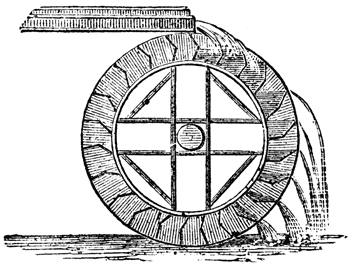
Doesn't it look familiar? Right down to the work wheel in the middle?

|
Since 1840, 170ish years ago, we know heat really is consumed in conversion to work, and doesn't need to be drained out. One might come to the opposite conclusion though,after looking at the heat engine model in every physics text book printed before 2012, on the left:
But wait, if we don't need to let the used heat out, what's the bit on the bottom for?
Do any current heat engines depend on draining heat? No.
Is it possible to create work by dissipating heat? No.
Do any commercial heat engines use an external fixed heat source? No.
The only true thing in the diagram is work is produced (somehow) from heat.
Still Quaint, after all these years!
170 years after the First Law, Conservation of Energy, shows that the amount of work you get is EXACTLY equal to the amount of heat consumed, we still have a drain on our heat engines to let out the used up heat!
The origin of the notion we need someplace to put the fallen heat is here: "Reflections", Pg 46 (Carnot) The production of motive power is then due in steam-engines not to an actual consumption of caloric, but to its transportation from a warm body to a cold body. Today, we know heat is actually consumed to create work. There is nothing left to transport to a cold body. The heat is gone, finito, kaput, nada, nothing, zilch, zip, zed, zero, not going anywhere because its already gone.
What's wrong with this picture?
In fact, the inside of a heat engine cannot tell what the external temperature is. But it is affected hugely by something not shown in any engine model, the external pressure.
Also not mentioned, is another item all heat engines have in common, they use a vapor (like air, steam or other matter, as long as it is in the gaseous state.)
And the last thing the all have in common, is they constrain a volume of vapor, then let it expand to move the engine. The motion comes from force generated by the pressure difference of its vapor and its containing pressure times the increase in volume.
|

